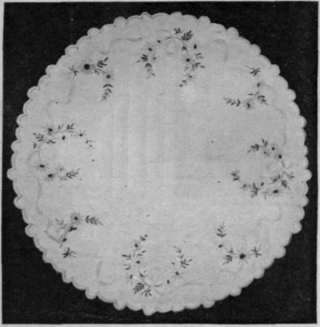14. Recreations
Description
This section is from "Every Woman's Encyclopaedia". Also available from Amazon: Every Woman's Encyclopaedia.
14. Recreations

A velvet d'oyley of charming design. Care must be taken to choose a small pattern, as each petal or flower must be completed by one stroke of the pen to do, and with a little practice small roses may be accomplished. But the difficulty with roses is that the stroke of the pen must be curved, and not straight, as in the case of the other flowers.
Those who do not feel competent to produce an original design should adopt the use of transfers, which can be bought at a fancy-work shop for a few pence. When ironing the transfer, care should be taken that the iron is not too hot, as silk and other light materials scorch very quickly.
When using chiffon, the best plan is to iron the transfer on to a piece of white blotting-paper, and pin the chiffon over it. The chiffon being fine, the design is clearly seen through it, and the danger of the pattern becoming smeared, or the chiffon slipping, is avoided.
Before beginning to trace the design, take a pastry-board, and fix the material firmly to it by means of drawing-pins. Immediately the work is completed, the blotting-paper should be removed, as the paint is liable to go through, and that, when dry, causes the materials to stick together.
Materials And Method
Ordinary oil paints and medium are used, which should be mixed together with a pen on the palette. Use a great deal of flake white for every mixture. Bright colours look much more effective than dark ones.
For table-centres, d'oyleys, and articles likely to be used in an artificial light, a great variety and brilliancy of colouring is suggested. A favourite design for a table-centre is a thick wreath of small flowers, in which pink, blue, mauve, and yellow, with green leaves and ribbons, are intermingled. The effect, though perhaps slightly garish by daylight, is merely sparkling and brilliant in the night-light.
The scheme of colouring having been thought out, and the paints mixed, the work can be commenced. A very small portion of paint is worked backwards and forwards so as to ensure an even thickness. Take a very small amount on the tip of the pen (a Lady nib being the best), place it at the top of the petal, and gradually press it down to the centre of the flower, thus completing one petal.
The reason for the small designs will now become obvious, as, by this means, the flowers and leaves gain a raised appearance. Ribbons and baskets are not done in this way, the flat effect of the ribbons being obtained by making the strokes lightly with the pen. The baskets look best when only outlined and lightly shaded. Care should be taken that nothing touches the wet paint, for, if it does, the design will in all probability be flattened, and the raised appearance spoilt.
When the painting is finished it should be left, as a rule, for at least a fortnight to dry. Light colours dry quickly, but those of a darker shade, especially mauve, take as long as six weeks or more. Even then there is likely to be a certain amount of moisture about it. When it is quite ready, the paint should have a hard, dry, shiny appearance.
Trimming
Take first the table-centres and d'oyleys. These look particularly well when edged with a dainty silver or gold lace, about an inch and a half wide for the former, and half an inch for the latter. A less expensive and very neat method is to buttonhole-stitch the edges with Mallard floss, choosing a shade to harmonise with the general scheme of colouring. A transfer edging can also be purchased, and, after having pressed it on to the material, it is buttonhole-stitched, and afterwards cut out with a pair of sharp scissors. Buttonhole-stitching should always be done before the painting, so as to incur less danger of the work getting spoilt. Cushions and tea-cosies look well when trimmed with cords or frills of silk, the same colour as the material chosen for the work.

A table-centre of white satin in French painting. This art is easily acquired and is most effective
Continue to:


